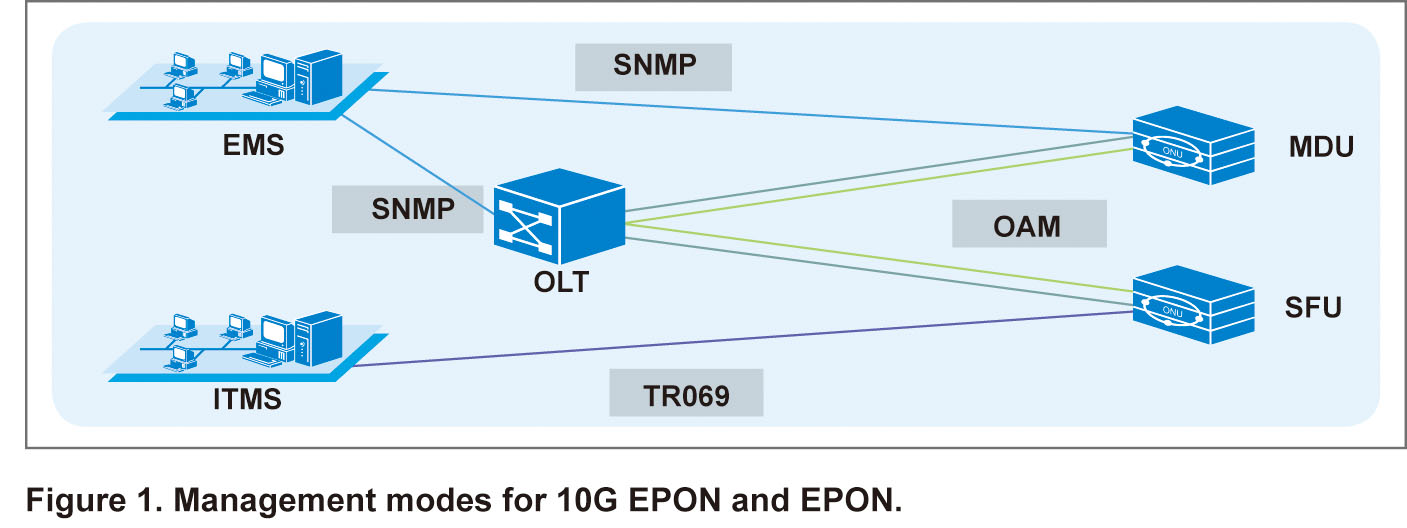Mature OAM: A Powerful Boost for 10G EPON
The maturing of EPON standards and technologies has ushered in large-scale commercialization of EPON networks. Today, EPON installations in China have exceeded 20 million lines. Being the leading EPON supplier in China, ZTE can deliver mature OAM solutions in light of the new characteristics of EPON networks.
ZTE has been integrating the research of FTTx OAM into its development of PON products. Its EPON OAM solution, drawing on years of field research experience, is highly recognized in China. It is helping Chinese operators push forward the construction of FTTx optical broadband access networks. ZTE’s EPON OAM solution offers the following advantages:
■ Equipment commissioning: It supports Plug and Play (PnP) functionality, fast and zero touch deployment, easy management address planning and configuration, and needs little change in the case of equipment failure.
■ Service provisioning: It supports multi-service configuration, as well as fast, centralized and batch service provisioning.
■ Equipment management: It supports unified equipment management. The management system is easy to operate and has high performance.
■ Service assurance: It provides early fault warning, remote fault diagnosis, and remote fault handling.
■ Network monitoring: It provides remote equipment monitoring and operation environment monitoring.
■ Network security: It provides equipment authentication, port location, user binding and user query.
The 10G EPON standards are derived from EPON standards. The IEEE 802.3av 10G EPON Task Force has taken into full consideration wavelength planning, control protocols, and management mechanisms in drafting the 10G EPON standards. Except for the expanded EPON MPCP protocol (IEEE802.3) and additional 10Gbps capability notification and negotiation mechanism, 10G EPON inherits almost all of the EPON standards, so it makes full use of the EPON OAM solution.
Since 10G EPON allows compatibility with and migration from legacy EPON networks, it is natural for a 10G EPON OAM solution to emerge from the basis of mature EPON OAM.
10G EPON and EPON have similar service models
As 10G EPON is similar to EPON in terms of equipment type, application scenario, VLAN model, and service identifier mapping, it is easy to learn and accept the service model of 10G EPON. Various types of ONU devices including SFU, HGU, SBU, MDU, and MTU, are recognized in the telecom market as useful in different application scenarios. These EPON ONU devices can be used for 10G EPON when their interface definitions are slightly modified. The service model and user model of EPON can also be used for 10G EPON.
10G EPON and EPON have similar service data
The configuration, performance and alarm data of 10G EPON and EPON are defined in the same specification. Their service models are simple, with relevant data being added to 10G EPON. EPON has a well-defined fault diagnosis function, which can be used in 10G EPON after changing the precision and scope of relevant data. In the EPON specifications, three bandwidth types are defined: fixed bandwidth, assured bandwidth, and best effort bandwidth. These bandwidth types are also defined in 10G EPON—except a few modifications are made to the data concerning bandwidth, precision and step size for Dynamic Bandwidth Allocation (DBA). The configuration, performance, and alarm data of EPON can also be used in 10G EPON after a few modifications have been made.
10G EPON and EPON have the same authentication mode and the same service fulfillment flow
As shown in Figure 1, EPON ONUs are managed in three modes: extended OAM, extended OAM and SNMP, and extended OAM and TR069. These management modes can be used for 10G EPON only by adding the extended OAM definition related to 10G EPON.

As the northbound interfaces of 10G EPON are fully compatible with those of EPON, all EPON interface parameters can be used for 10G EPON. As a result, the whole OAM flow of 10G EPON remains unchanged without the need to develop new interfaces or alter its service support system.
10G EPON leverages the simplicity, low cost, and mature industrial chain of the EPON and Ethernet technologies, and its large-scale commercialization is just around the corner. Global mainstream operators have predicted that 10G EPON will see widespread commercial installation within one year, and its technologies and industrial chain will experience booming growth.
Currently, major operators worldwide are paying increasing attention to 10G EPON. Some of them—like Japan’s NTT DoCoMo, Korea’s KT, France Telecom, Telecom Italia, and Taiwan’s Chunghwa Telecom—are conducting 10G EPON technology and equipment assessment, and some of them have even run 10G EPON field trials.
Thanks to the strong affinity between 10G EPON and EPON, the 10G EPON OAM solution based on mature EPON OAM can effectively guarantee the smooth commercialization of 10G EPON.
relative articles